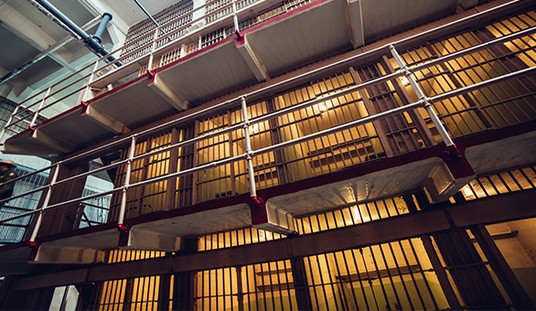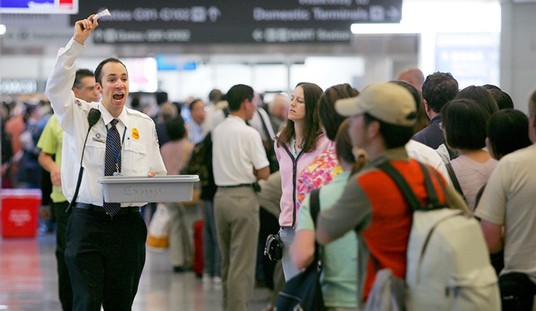Between innings at most professional baseball games, young and lithe cheer squads prance out onto the field near the foul line accompanied by a goofily costumed team employee to unleash a Hobbesian “state of nature” on the assembled crowds.
Armed with a T-shirt cannon and a dozen more balled up pieces of sweatshop-made team gear, the group whips the game’s attendees into a frenzy by teasing them with the prospect of their very own branded piece of junk.
Each and every time, the crowd obliges. When a shirt lands within a few dozen yards of the rabble, the mass of humanity pushes and tramples one another in a pell-mell fashion. Occasionally, grown men rob children of the worthless rags only to be booed by the crowd, envious that they were not as “fortunate” to deny the child the joy of ownership of the future dish towel.
The brutish spectacle is being replayed on a scale hitherto unseen, not by drunken sports fans, but by our elected betters –officials and bureaucrats alike – over the site location of Amazon’s second headquarters.
Although the bidding processes for professional sports franchises and the Olympic games are deeply corrupt and reek of desperation, the HQ2 is more sinister and sad. It is not as much about civic pride as despair and distress. It recalls a broken and bankrupt gambler’s last throw of the dice — going all in with house and kids’ college fund.
And today was the deadline to place your bid with Amazon as over 100 cities all over North America are expected to file with the Seattle-based online retail behemoth.
The cities want the promised $5 billion investment, 50,000 well-paying jobs, and snazzy office park to come to their town and are willing to mortgage the future to get them. Most have offered a mixture of economic incentives (tax breaks and direct subsidies) and infrastructure improvements and free land.
Others have resorted to gimmicks like Birmingham, Alabama which put up giant Amazon delivery boxes across the region. Some cities offered to change their name. Others were just dumb like blighted Gary, Indiana’s decision to take out a full-page New York Times print ad, which costs between $50,000 and $100,000. (NB: Amazon CEO Jeff Bezos owns the rival Washington Post, lives in Seattle, and Amazon is a digital company).
It truly is a race to the bottom, for a booby prize.
Impoverished hellscape Newark, New Jersey offered more money ($7 billion) to Bezos’ firm than Amazon would actually be ponying up.
Nevermind that Amazon is still not that profitable compared to its valuation – only going into the black for the first time recently (sic) and posting disappointing earnings in Q2 2017. (It won’t post Q3 earnings until end of this month, and stock watchers are wary.)
Or that these government-backed investment “incentives” a.k.a. schemes almost never deliver on promised jobs, capital, and long-term growth. In New York State, Governor Andrew Cuomo’s pet project for revitalizing moribund Upstate New York’s economy is a joke – on taxpayers. Cuomo’s face was ubiquitous on TV ads nationally promoting the program to the tune of $53 million but the expected 10,000 jobs never came despite the state giving away $60 million to date.
Tech companies, the taxpayer’s dependents under Cuomo’s scheme, either never came or dropped out of the program. To date, a measly 1100 jobs have been created by companies in the program – most of which probably cannot be truly attributed to the incentives or will stick around when they lapse.
Back in the 1970s, western Pennsylvania, reeling from the collapse of Big Steel, “won” a Volkswagen plant and the whole thing cost taxpayers $90 million – even borrowing against the state pension fund to finance the deal. The predictable result? They don’t make VW’s in Pennsylvania but the state’s pension plan sure is broke. (Don’t worry: the state is subsidizing subsequent tenants at the site to this day and the cities around the plant still look like a neutron bomb went off).
The list of failed subsidy schemes goes on because the free market doesn’t care if the government is banking on promised private enterprise’s knock-on effects. It’s brutal and the second someone beats Bezos at his own game – poof.
Crony capitalism does not work but it does not mean politicians will stop trying it because creating a growth-oriented, long-term fiscal plan and healthy business climate is hard work. Voters might get tired of their elected officials making tough decisions on school and pension funding obligations or complain their lay-about child can’t get one of those high-paying tech jobs, without any discernible skills.
Furthermore, those coding and sales jobs that Amazon might bring won’t be going to the unemployed and unemployable – you know, the folks that should be working. Instead, Amazon will import tens of thousands of its Seattle-based qualified workforce, drive up the cost-of-living and taxes, and split town the second the spigot gets turned off.
Worse yet, every bidding site has now revealed to the whole world – and especially its local business community – its utter desperation for a quick fix to its economic woes. The cities and states have a target on their back from the cronyists who will exact similar concessions for their enterprises going forward, threatening either to leave or promising to grow – if only the government ponies up.
Lastly, the whole thing is a farce. A well-placed source at Amazon tells me the HQ2 site is locked in and the bidding process has been kabuki theatre to extort the actual site’s officials for more government goodies.














Join the conversation as a VIP Member